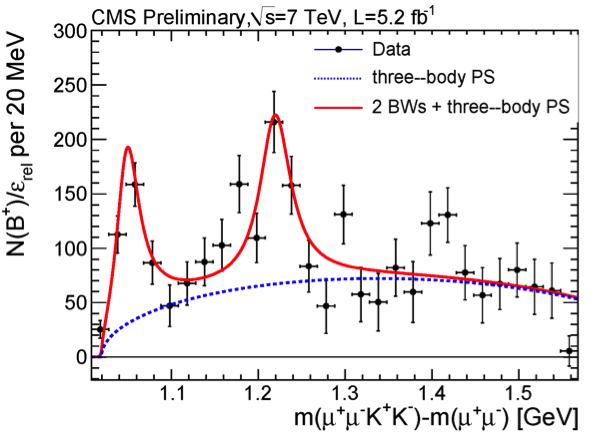
In the vast particle landscape, there are, to borrow a phrase, known knowns (the Standard Model, for example), unknown unknowns (exotic extensions of the Standard Model and beyond), and those ever-interesting known unknowns. A recent CMS observation perfectly fits into this third category.
When looking at proton collisions where a J/ψ and a φ meson are produced, CMS observed two unexplained peaks in the data. The first of these structures is consistent with a similar observation made by the CDF collaboration at the Tevatron in 2009, known as Y(4140). CMS searched for these exotic states in decays of the B+ meson, which produce three particles: J/ψ, φ and K+. From these decays, it is possible to study only the J/ψ-φ part by looking at decays producing two muons from the J/ψ and two K mesons from the φ. Sifting through approximately 2,500 B+ decays with a virtual fine-tooth comb revealed two peaks (see figure) corresponding to particle states with masses of around 4148 MeV and 4316 MeV respectively. This is the largest-ever data sample of such decays, collected from 5.2 fb−1 of proton collisions in 2011 at a centre-of-mass energy of 7 TeV. In 2009, CDF noticed a deviation from the expected background shape (shown in the CMS figure as the blue line) in the form of an excess in the data around a mass of 4140 MeV, which gave this mysterious peak its designated name. Other experiments have sought to verify independently the existence of this structure without success.
Until now, that is: In observing an excess at the same mass in the same decay channel as CDF did, CMS has now provided the first confirmation that such a structure actually exists. The interpretation of the second peak CMS observed is complicated by possible interference from φK resonances.
New particle states have been discovered aplenty over the last decade, but these puzzling and unexplained states are a serious challenge to the conventional quark model. One of the possible explanations is that it is a new type of hadron: not a meson made up of a quark and an antiquark or a baryon made of three quarks or antiquarks, but a composition of two quarks and two antiquarks — two mesons stuck together. Studying the data collected in 2012 will help better understand the nature of these two observations and help further explore the world of quantum chromodynamics.
- Log in to post comments

